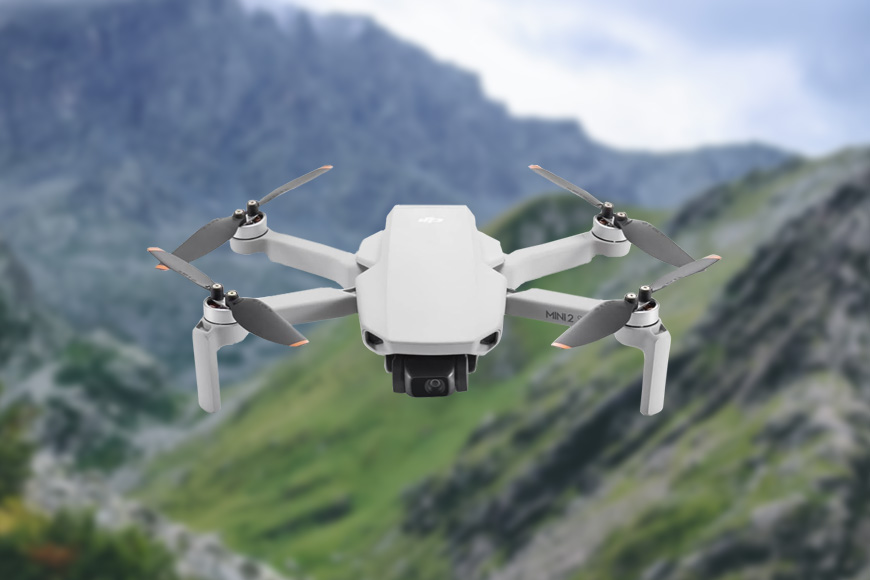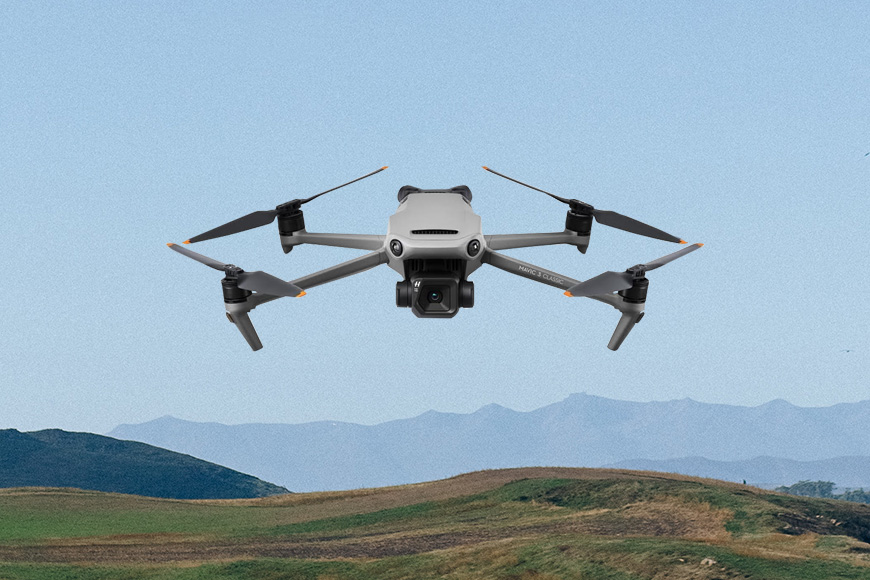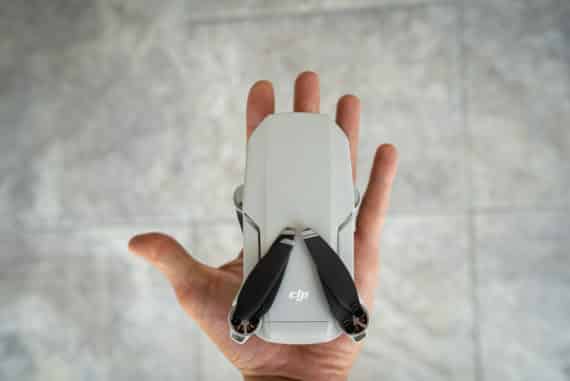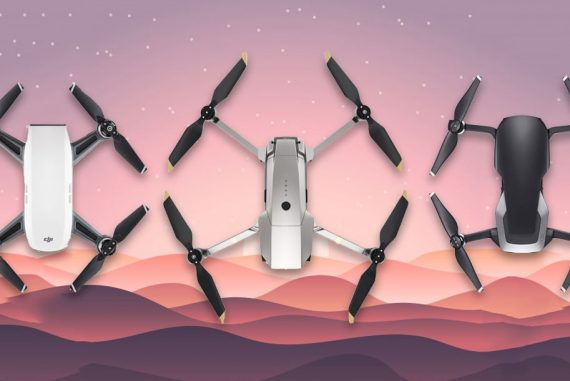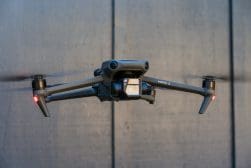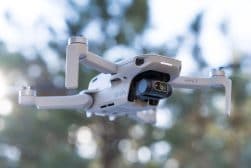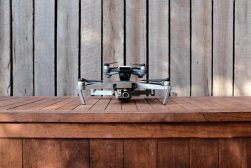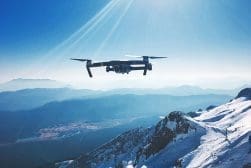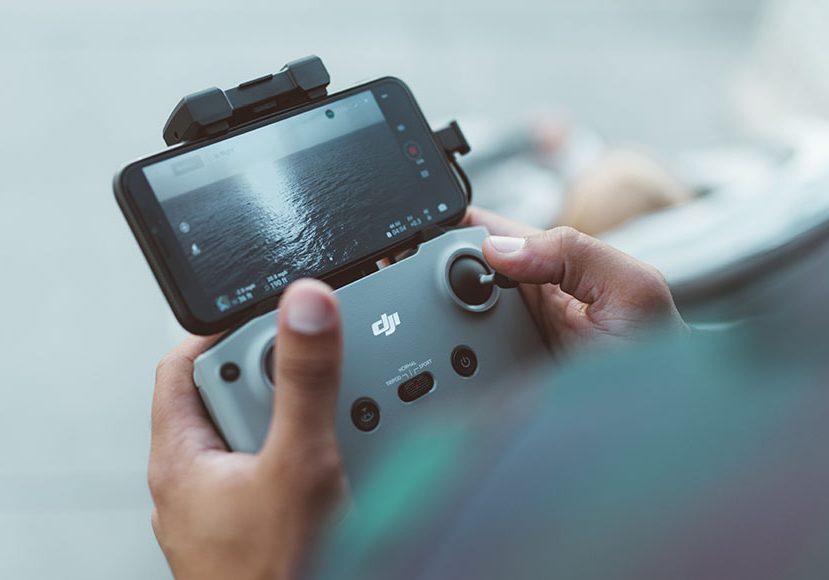
Quietest Drones of 2024 for Silent Aerial Filming
Explore the most silent drones of the year, ideal for unobtrusive aerial filming and capturing high quality video and photo footage without noise distractions.
Using the quietest drone makes flying a much less stressful experience.
A silent drone brings less attention, which means not disturbing neighbors or alerting bystanders.
The noise from a drone’s propellers can be annoying and even intimidating to people and animals.

Unparalleled blend of affordability, advanced noise-reduction technology, and top-tier filming capabilities, making it the best value quiet drone on the market.
In addition, a drone that makes less noise above you is useful when you’re filming on the ground at the same time.
After all, no one wants to remove the audio of a drone’s whirring from their video footage.
Let’s take a look at which drone is the quietest of the year.
What are the Quietest Drones in 2024?
DJI Air 3 | Best Value Quiet Drone on Test

- High-resolution video and photos
- Great battery life
- Good low-light performance
- Offers waypoints
- Not the quietest drone
- Need ND filters for day shoots
This is a great drone. It’s not one of the quietest drones on the list, but it still comes in at a respectable 65 dB at a 10-metre distance.
It has a dual camera set-up, with 24mm and 70mm lenses, which both use the same 48-megapixel sensor.
The lenses have fixed apertures, f/1.7 on the 24mm and f/2.8 on the 70mm. These low apertures mean that they have great low-light performance, although you’ll need ND filters for daytime shoots.
It shoots 4K video with 10-bit HLG/D-LOG M colour profiles for cinematic quality, plus 48-megapixel RAW photos.
The video can also be shot on a vertical setting, which is essential for social media use, although this is not achieved through the lens tilting, but the footage cropping in, so there’s less resolution (2.7K).
It boasts 48% more battery life than its predecessor, which works out at 46 minutes of flight time on a full charge, making this an ideal drone for real estate photography or any other genre that requires you to be up in the air for a long time.
The DJI Air 3 has waypoints. This means you can plot a flight line, set varied gimbal tilts, and heights, and then the drone will fly off and do it for you, following the program.
You also have active track – which can track you from a full 360 degrees – and cruise control, to keep consistent speeds for extra-smooth flying and filming.
And, the body is well-covered with omnidirectional sensors. No need to worry about smashing your drone into any obstacles as it can detect and avoid them.
DJI Mavic 3 Pro | Quiet Drone for Professionals

- Three cameras
- Shoots up to 5K video
- Hasselblad sensor on the main camera
- RAW image files
- Irritating gimbal cover
- Very expensive
The DJI Mavic 3 Pro (review) is the most expensive drone on the list, but that’s for good reason, as it’s one of the most popular drones amongst professionals.
It’s not the quietest drone, with a 64 dB output at a 10-metre distance, but that’s still pretty good given the size and weight of the drone.
One of its main selling points is its three lenses of three different focal lengths.
The main camera, which is 24mm, has an adjustable aperture of f/2.8 to f/11, so it’s good in all light conditions.
It shoots a maximum of 5K resolution footage at 50fps in 10-bit colour, 4K slow motion at 120 fps, and 20-megapixel RAW stills.
The sensor for that main lens is a Hasselblad, so you can imagine the excellent image quality you can expect.
The other camera lenses are a medium telephoto of 70mm, and a telephoto of approximately 166mm equivalent.
While they can’t quite match the resolution of the main camera, they can still both shoot 4K at up to 60 fps.
The drone’s flight time is slated to be 43 minutes on a full charge, and it can be operated up to 15 kilometres away.
DJI Mini 3 Pro | Best Budget Quiet Drone
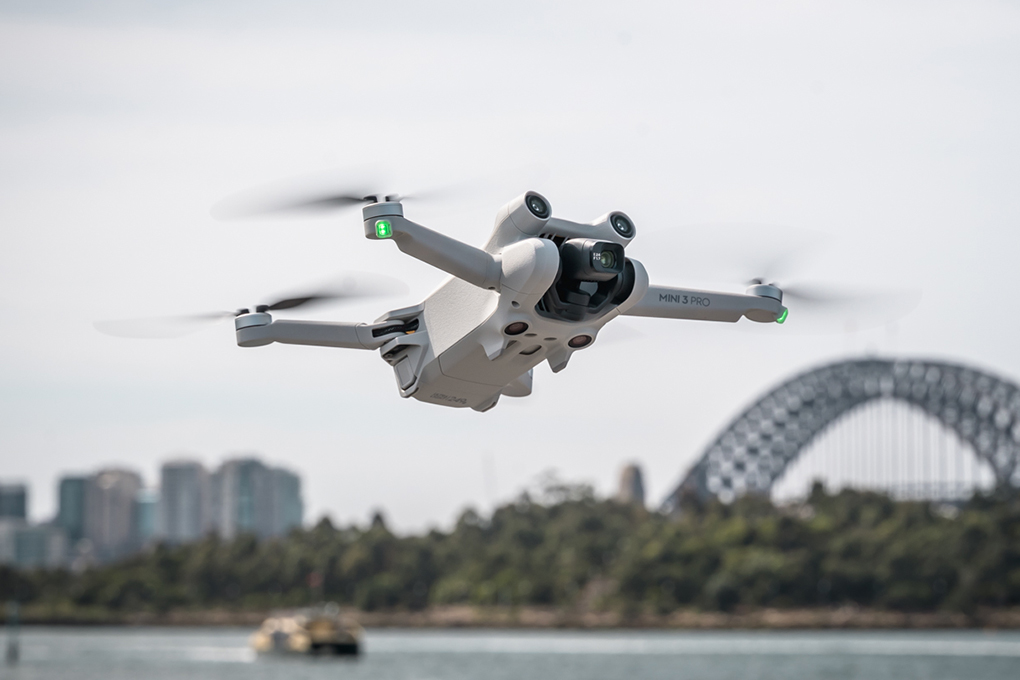
Credit: Tommy Williams
- Compact and durable
- Very quiet drone
- Affordable
- Vertical shooting option
- Fixed aperture means you need ND filters for day shoots
- Not good in the wind
The DJI Mini 3 Pro is one of the cheaper quiet drones in this guide, and it is also the quietest drone here, with an output of 52 dB at a distance of 10 metres.
It’s very compact, folds up small, and weighs very little. At just under 250 grams you’re able to legally fly it in many more locations than most other drones, as there’s no need to get a certificate or special authorisation to do that.
Its low weight means that it’s not the best drone to use in high winds. But, on the other hand, because it’s light, it’s also incredibly durable and survives crashes that would break heavier drones.
The Mavic 3 Pro is also a great selfie drone, boasting a neat Active Track feature that can follow a subject.
It shoots 4K at 30fps, 2.7K at 60fps, and 1080p 120fps, plus, it can do that by shooting vertically. Unlike other drones, it doesn’t crop footage to do this, you tilt the camera, so you don’t lose any resolution.
Another feature that adds to this mini camera drone‘s portability is the fact that the battery case is also a charger, which is great when you’re on the go.
Now there’s also the Mini 4 Pro – we’ll update this guide when we get around to reviewing it.
DJI Mini 2 SE | Great Value Quiet Drone
- Great for beginners
- Good price
- Relatively quiet drone
- Intelligent modes make it easy to learn
- Compact
- Lower resolution footage
This is the lowest-priced quiet drone in this guide, but it nevertheless still has good specs considering it’s a budget option.
Also, considering these drones are aimed at the beginner market, they don’t do too badly in terms of noise either. They are not silent drones, by any means, but they produce 60 dB at 10 metres.
The DJI Mini 2 SE is compact and easy to pack away, and it weighs less than 250 grams, so there’s no need to register it, and fewer restrictions on where you can use it.
Despite its low weight, it’s still very stable in the air and doesn’t have too many issues flying in the wind.
A full charge will give you 31 minutes of flight time, and in that time, you can capture 2.7K video at 30fps, and 1080p at 60fps.
You can fly it up to 10 kilometres away, and, if the controller dies or the drone’s battery starts to run low, it will automatically fly back to where the controller’s last signal came from.
So, technically, you should never lose it.
Mavic 3 Classic
- Adjustable flight speed
- These are reasonably quiet drones
- High-quality sensor
- AI-assisted night filming
- No zoom camera
These are solid, reliable drones with professional-level features. As for the noise they produce, they’re not the quietest drones, but their output is about 60 dB at 10 metres.
It has a 5.1K Hasselblad sensor with Hasselblad colours, which provide you with unmatched quality, dynamic colour, and loads of detail.
You can film in both D-LOG -which is a nice, flat colour profile for editing – and HLG, for higher definition footage. And that footage can be shot at up to 50fps.
Even though it doesn’t have a zoom lens, because of its high-resolution sensor, you can crop in and still have very high-resolution footage.
The Mavic 3 Classic is packed with professional-level features.
You get waypoints, cruise control, and speed control. Yes, you can change your flying speed, all the way down to 1 metre per second.
Plus, its night video mode uses AI to automatically reduce noise, so night footage is smooth right out of the camera, with no need for denoising in editing software.
It also includes 360-degree tracking. Unlike older drones that could only track you from the side or single point, this can track a subject from anywhere.
The Mavic 3 Classic is strong and stable even in high winds. Its body is covered in omnidirectional sensors to help it avoid in-flight obstacles.
Autel EVO II Pro V3
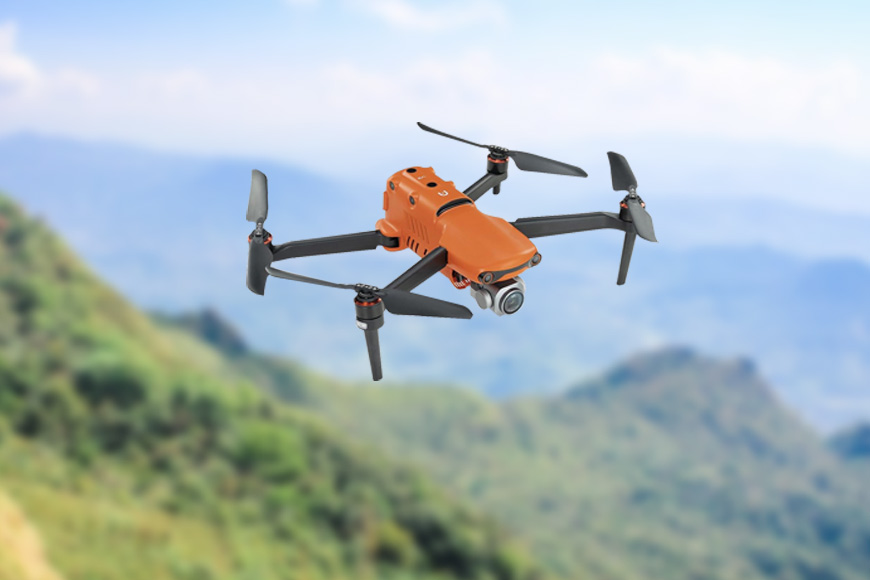
- Variable aperture lens
- Very quiet drones
- Good low-light capabilities
- Waypoints
- Can be difficult to find retailers
The Autel EVO II Pro V3 is pretty expensive but, as it includes noise suppression, is one of the quietest drones, registering 54 dB at 10 metres.
It’s a good all-round machine with a lens that has a variable aperture of f/2.8 – f/11.
It shoots video at up to 6K at 30fps, and 20-megapixel, 12-bit RAW stills.
It offers a range of shooting modes – time-lapse, HDR, and burst shooting – and with its maximum ISO of 44000, gives you great low-light performance.
These quiet drones also use something called a ‘moonlight algorithm’ to automatically reduce the noise in nighttime footage.
You can fly it for up to 40 minutes on a single charge, and up to 15 kilometres away.
It also has many useful features you’d expect from a drone at this level, with 360-degree obstacle avoidance, automatic path planning, and an auto-return feature that will get your drone home safely, whatever the situation.
How Do You Measure Drone Volume?
The noise produced by drones is measured in decibels (dB).
Decibel level increases are logarithmic, which refers to a scale where each step or unit increase represents a multiplication, rather than a simple addition.
In the context of decibels, a logarithmic increase means that every 10-decibel rise results in a sound that is 10 times more intense.
So, instead of growing in a straight line (like 1, 2, 3, 4…), it grows in multiples (like 1, 10, 100, 1000…). This is why a small increase in decibels can result in a sound that is much, much louder.
This means for example that a drone with a noise level of 70 decibels (the sound of average car traffic) would be 10 times louder than a drone working at 60 decibels (the sound of a normal conversation at close range) of noise.
Similarly, a drone doing 80 decibels (strong alarm clock close to the head) would thus be 100 times louder than a 60-decibel drone.
Here’s how drone volume is typically measured:
- Sound Level Meter (SLM): This is the most common device used to measure sound levels. It captures fluctuations in atmospheric pressure caused by sound waves and converts them into decibel readings.
- Positioning: When measuring drone noise, the SLM is typically positioned at a specific distance from the drone, often directly below its flight path. This ensures consistency in measurements.
- Background Noise: It’s essential to account for ambient or background noise when measuring drone volume. Measurements are often taken in quiet environments, or the background noise level is subtracted from the reading to get an accurate measure of the drone’s noise.
- Frequency Weighting: Human ears don’t perceive all frequencies equally. We are more sensitive to some frequencies than others. Sound level meters often use “A-weighting” (denoted as dBA) to mimic the frequency sensitivity of the human ear.
- Drone Operations: The noise level can vary based on what the drone is doing. Hovering, ascending, descending, or moving horizontally can produce different noise levels. Therefore, measurements might be taken during various operations to get a comprehensive understanding of the drone’s noise profile.
- Comparative Analysis: By measuring the noise levels of different drones under the same conditions, one can compare and determine which drones are quieter and under what operating conditions.
Remember that the volume is different to the sound produced by a drone.
Some models such as the Mavic Mini series produce a raspy ‘wasp-like’ sound which can actually be more annoying to bystanders than a lower (but louder) sound produced by something like the Mavic Pro series.
How to Make a Drone Quieter
Making a drone quieter can enhance user experience, reduce disturbances to wildlife, and make drones more acceptable in populated areas.
Here are some tricks and tips to reduce drone noise:
-
Propeller Design:
- Upgrade to Quieter Propellers: Some manufacturers offer “low-noise” propellers designed to produce less noise than standard ones.
- Increase Propeller Size: Larger propellers can often turn slower to produce the same amount of thrust, which can reduce noise.
- Opt for More Blades: Tri-blade or quad-blade propellers can sometimes be quieter than standard two-blade designs.
-
Reduce Vibrations:
- Balanced Propellers: Unbalanced propellers can cause vibrations leading to more noise. Ensure propellers are balanced using a propeller balancer.
- Dampening Pads: Use vibration-dampening pads or gels between the drone body and motors to reduce vibrations.
-
Flight Techniques:
- Gradual Movements: Sudden accelerations or sharp turns can increase noise. Use smooth and gradual control inputs.
- Fly Higher: Noise dissipates with distance. Flying a bit higher can make the drone less noisy to people on the ground.
-
Flight Environment:
- Flying over surfaces that absorb sound (like grass or forests) can seem quieter than flying over reflective surfaces (like concrete or water).
-
Sound Masking with Ambient Noise:
- Lawn Mowing: If someone is mowing the lawn or using other loud equipment, the noise from these activities can effectively mask the sound of a drone, especially if the drone is flying at a higher altitude.
- Natural Sounds: Flying near areas with naturally loud ambient sounds, like waterfalls, rivers, or windy areas, can also help mask drone noise.
-
Time Your Flights:
- If you know there will be other loud activities happening, like construction work or busy traffic time, you can time your drone flights to coincide with these periods.
-
Use Sound Barriers:
- Physical barriers, like walls, buildings, or trees, can act as sound barriers. Flying on the other side of a sound barrier from where people are located can help reduce the perceived noise.





